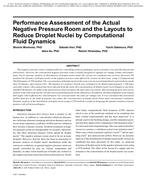Description
The negative pressure room is indispensable for controlling airborne pathogens such as measles virus and Mycobacterium tuberculosis. However, the conventional negative pressure room is usually designed to regulate air change volume and temperature, but no dynamic analysis of distributions of droplet nuclei under the various air conditions has yet been discussed. We analyzed the dynamics of droplet nuclei in the negative pressure room affected by various air directions, using a Computational Fluid Dynamics (CFD) method. The concentrations of droplet nuclei in the room were increased immediately and reached a steady state 30 minutes, after patient entry. The droplets in a patient’s breath were estimated to be diluted approximately 1,100 times soon after release. Once patient has been removed from the room, the concentrations of droplet nuclei were dropped to one thousandth by 60 minutes. No reflux to the anteroom was observed unless the inner door was closed. After opening the door, the concentrations in the anteroom and the corridor increased dramatically by the refluxed air. In addition, the ideal alignment of an exhaust and supply which affected the concentrations was assessed under the same air change rate. It was concluded that directional airflow from feet to the head of patients can reduce the concentrations of droplet nuclei better than conventional ventilation. Dynamic analysis of the distribution of droplet nuclei using a CFD method is useful in designing the optimal isolation room for patients with airborne pathogens.
Citation: IAQ Conference: IAQ 2010: Airborne Infection Control
Product Details
- Published:
- 2011
- Number of Pages:
- 8
- File Size:
- 1 file , 390 KB
- Product Code(s):
- D-IAQ2010-C104-10




